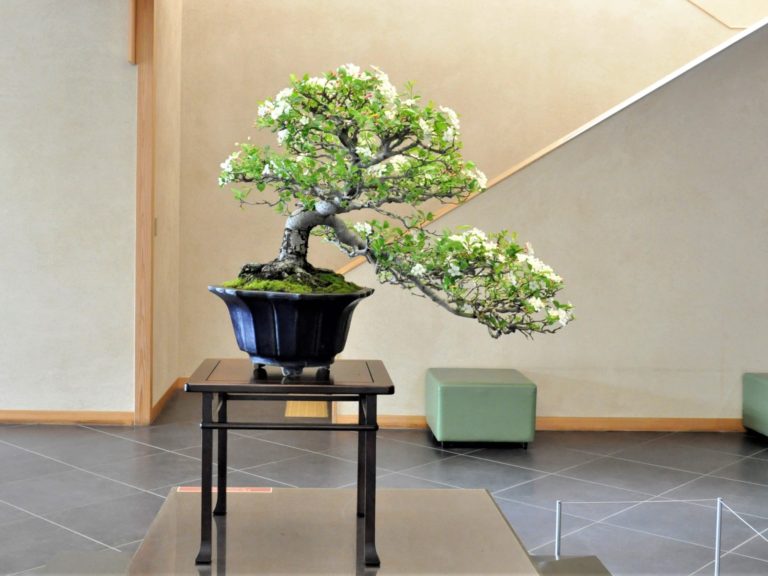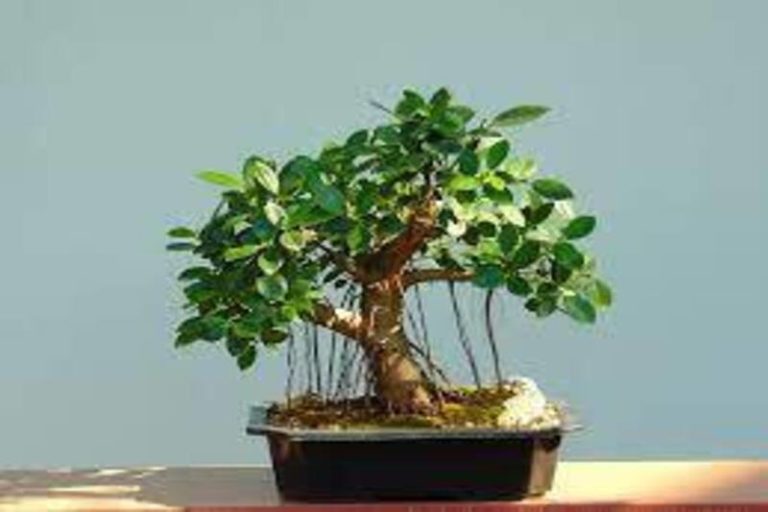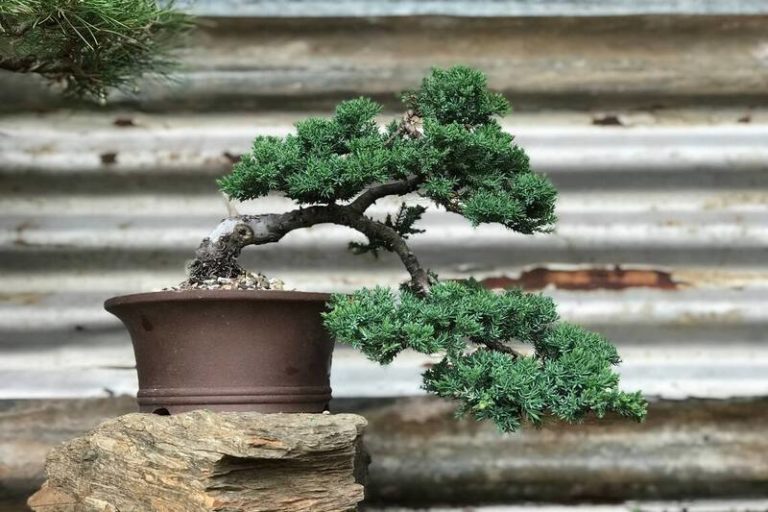Red Dragon Maple Bonsai : A Stunning Addition to Your Garden
Bonsai is an art form that involves growing miniature trees in containers, and one captivating variety is the Red Dragon Maple Bonsai ( Acer palmatum ) . In this article, we’ll explore the beauty and unique characteristics of the Red Dragon Maple bonsai, along with essential care tips to help you nurture and maintain this delightful tree.
What is a Red Dragon Maple Bonsai?
A Red Dragon Maple Bonsai is a small tree, scientifically known as Acer palmatum dissectum ‘Red Dragon.’ It is a unique bonsai variety admired for its striking red foliage and finely dissected leaves. Originating from Japan, this bonsai tree exhibits a graceful growth habit and captivates with its stunning display of fall colors, including shades of red, orange, and gold. With proper care, including appropriate light exposure, regular watering, and pruning, the Red Dragon Maple Bonsai can thrive and add beauty to any bonsai collection or garden. Its exquisite foliage and distinct growth characteristics make it a sought-after choice among bonsai enthusiasts.
History and Origins of Red Dragon Maple Bonsai
The history and origins of Red Dragon Maple Bonsai can be traced back to its parent tree, the Japanese Maple (Acer palmatum). The Japanese Maple is a species of maple native to Japan, known for its stunning foliage and ornamental value. Over centuries, Japanese horticulturists selectively bred and cultivated different varieties of Japanese Maples, including the Red Dragon Maple.
The Red Dragon Maple, or Acer palmatum dissectum ‘Red Dragon,’ is a cultivar that was specifically developed for its unique characteristics. It was likely bred through selective crossbreeding and propagation techniques to enhance traits such as the vibrant red color of its foliage and the finely dissected leaf structure.
Even though the exact timing and people who worked on the Red Dragon Maple Bonsai are not well known, it is a great example of the skill and creativity of Japanese bonsai fans and gardeners. Their hard work to improve and create beautiful bonsai types like the Red Dragon Maple has added to Japan’s long and rich history of bonsai growing..
Today, bonsai fans all over the world love Red Dragon Maple Bonsai for its beautiful look and unique qualities. It shows how much skill and love go into growing and caring for these tiny works of art.
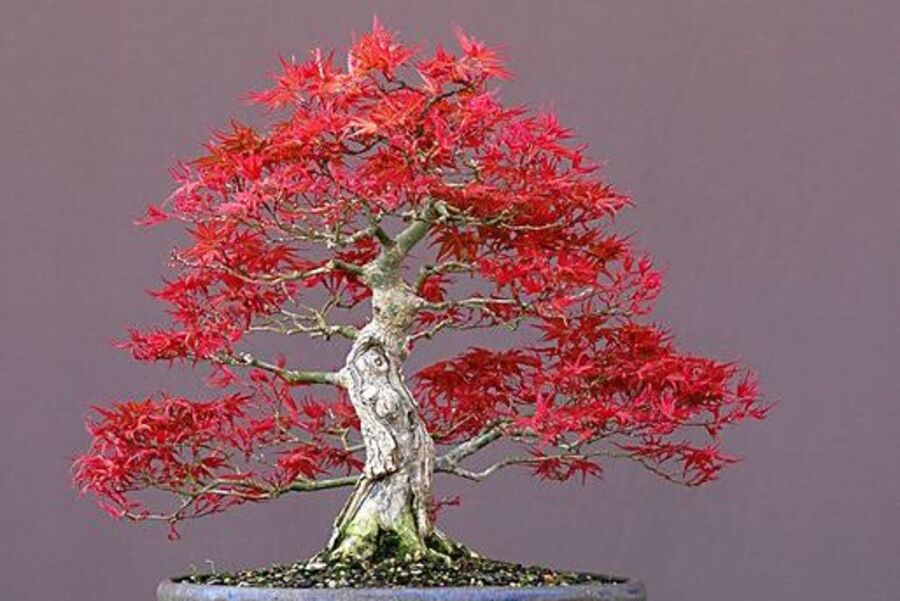
Red Dragon Maple Bonsai and Their Symbolism
Red Dragon Maple Bonsai holds symbolism that reflects both the broader cultural significance of bonsai as well as specific associations tied to the characteristics of the Red Dragon Maple itself.
1. Harmony and Balance: Bonsai as an art form symbolizes harmony between nature and humans. The miniature size and controlled growth of Red Dragon Maple Bonsai represent the balance achieved between the natural beauty of the tree and the intentional shaping and nurturing by the bonsai artist. It serves as a reminder of the importance of finding balance and tranquility in life.
2. Beauty and Elegance: The Red Dragon Maple Bonsai is known for its vibrant red foliage and delicate leaf structure. These attributes symbolize beauty and elegance, evoking a sense of grace and refinement. The bonsai’s captivating appearance can inspire appreciation for the simple yet profound beauty found in nature.
3. Strength and Resilience: Bonsai trees, including the Red Dragon Maple, require careful care and maintenance to thrive. Their ability to endure and adapt to various conditions symbolizes strength and resilience. The bonsai serves as a reminder of the strength within us to overcome challenges and grow, even in adverse circumstances.
4. Seasonal Changes and Impermanence: The Red Dragon Maple Bonsai undergoes dramatic color transformations during the autumn season, displaying vibrant red, orange, and gold hues. This symbolizes the transient nature of life and the beauty found in embracing change. It reminds us to appreciate the present moment and recognize the ever-changing cycles of life.
5. Cultural Significance: In Japanese tradition, the dragon represents strength, wisdom, and good fortune. The name “Red Dragon Maple” has symbolism associated with the dragon, stressing positive connotations with power, auspiciousness, and wealth.
6. Overall, Red Dragon Maple Bonsai combines the broader symbolism of bonsai as a representation of harmony and balance with the specific attributes of the Red Dragon Maple tree. Its symbolism encompasses beauty, elegance, resilience, impermanence, and cultural significance, making it a meaningful and captivating addition to bonsai collections and gardens.
Characteristics of the Red Dragon Maple Bonsai
The Red Dragon Maple Bonsai (Acer palmatum dissectum ‘Red Dragon’) possesses distinct characteristics that make it a sought-after and captivating bonsai variety. Here are some notable features of the Red Dragon Maple Bonsai:
- Foliage Color: The Red Dragon Maple Bonsai is renowned for its vibrant red foliage. The leaves exhibit intense shades of red, ranging from deep crimson to bright scarlet. This striking coloration adds a dramatic and eye-catching element to the bonsai.
- Leaf Structure: The leaves of the Red Dragon Maple Bonsai have a finely dissected or lace-like structure. Each leaf is deeply lobed, creating an intricate and delicate appearance. This characteristic contributes to the bonsai’s overall elegance and visual appeal.
- Growth Habit: The Red Dragon Maple Bonsai has a graceful and cascading growth habit. Its branches arch gently downward, creating an elegant and flowing silhouette. This cascading form adds a sense of movement and dynamic beauty to the bonsai’s overall composition.
- Fall Colors: During the autumn season, the Red Dragon Maple Bonsai undergoes a stunning transformation. The leaves transition to vibrant shades of red, orange, and gold. This display of fiery autumn colors adds a captivating and enchanting element to the bonsai, making it particularly striking during this season.
- Size and Proportions: As a bonsai, the Red Dragon Maple is cultivated and trained to maintain a miniature size. The tree typically reaches a height of around 1 to 3 feet (30 to 90 cm) when fully mature. Its compact proportions make it suitable for displaying indoors or in smaller garden spaces.
- Durability: The Red Dragon Maple Bonsai is well-known for its versatility and resilience. When properly cared for, it can tolerate a variety of climates and is relatively hardy. Because of its endurance, it is a favorite option among bonsai lovers of all skill levels.
The unique combination of vibrant red foliage, finely dissected leaves, cascading growth habit, stunning fall colors, compact size, and durability make the Red Dragon Maple Bonsai a captivating and sought-after variety among bonsai enthusiasts. Its distinct characteristics contribute to its overall visual appeal and make it an excellent choice for bonsai collections and garden displays.
| Attribute | Information |
|---|---|
| Botanical Name | Acer palmatum |
| Other Name | Japanese Maple |
| Native Area | Japan, Korea, China |
| Plant Type | Deciduous Tree |
| Fertilizer | Balanced, slow-release in spring and summer |
| Growth | Slow to Moderate |
| Light Requirement | Partial Shade to Full Sun |
| Propagation | Seeds, Cuttings, Grafting |
| Soil Type | Well-Draining Bonsai Soil Mix |
| Temperature | Varies |
| Watering | Keep soil consistently moist |
| Toxicity | Generally Non-Toxic, sap may cause irritation |
| USDA Zones | 5-8 |
Types of Red Dragon Maple Bonsai
While “Red Dragon Maple Bonsai (Acer palmatum dissectum ‘Red Dragon’) refers to a specific cultivar, there are various types or variations of Red Dragon Maple Bonsai that can be found. These variations may differ in terms of growth habit, leaf coloration, or other unique characteristics. Here are a few common types of Red Dragon Maple Bonsai:
Standard Red Dragon Maple: This refers to the standard or typical Red Dragon Maple Bonsai variety. It showcases the characteristic cascading growth habit with finely dissected red foliage, creating an elegant and captivating display.
Dwarf Red Dragon Maple: Some Red Dragon Maple Bonsai varieties are specifically cultivated to have a more compact and dwarfed growth habit. These bonsai trees exhibit the same vibrant red foliage and finely dissected leaves, but in a smaller and more condensed form.
Weeping Red Dragon Maple: The weeping variation of Red Dragon Maple Bonsai has a more pronounced cascading growth habit. The branches hang down dramatically, creating a weeping or pendulous effect. This adds a unique and striking element to the overall composition of the bonsai.
Variegated Red Dragon Maple: Occasionally, Red Dragon Maple Bonsai may display variegation in their foliage. Variegated variations feature leaves with contrasting colors such as red and pink or red and green, creating a beautiful and visually interesting pattern.
Fall Color Variation: While all Red Dragon Maple Bonsai exhibit stunning fall colors, there can be variations in the intensity or shades of those colors. Some variations may display more vibrant red hues, while others may have a mix of red, orange, and gold tones.
It’s important to note that the availability of specific types or variations of Red Dragon Maple Bonsai may vary depending on nurseries or bonsai growers. Bonsai enthusiasts can explore and select from these different types to find the Red Dragon Maple Bonsai that best suits their aesthetic preferences and desired characteristics.
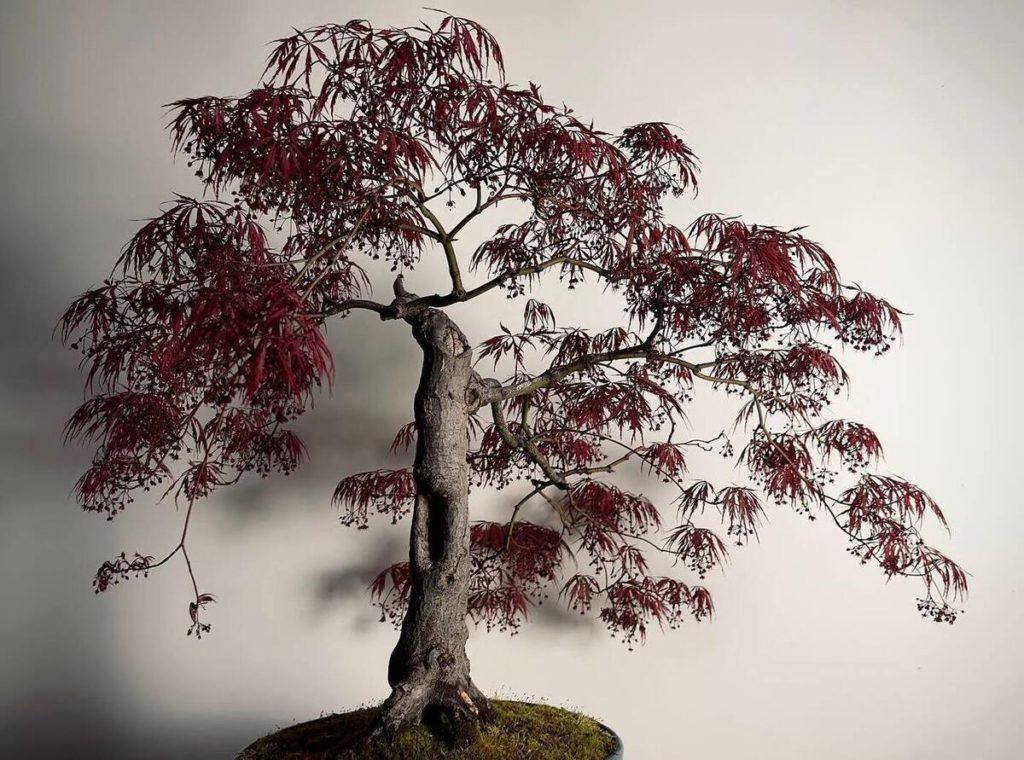
How to Grow a Red Dragon Maple Bonsai
Growing a Red Dragon Maple Bonsai (Acer palmatum dissectum ‘Red Dragon’) requires careful attention to its specific needs and the application of proper bonsai cultivation techniques. Here are the essential steps to growing a Red Dragon Maple Bonsai:
1. Selection of a Bonsai Tree: Choose a healthy Red Dragon Maple tree from a reputable nursery or bonsai supplier. Look for a tree with well-developed branches, vibrant foliage, and a strong root system.
2. Container and Soil: Select a suitable bonsai container with adequate drainage holes. Use well-draining bonsai soil or a mixture of akadama, pumice, and lava rock to ensure proper water retention and aeration.
3. Pruning and Shaping: Begin shaping your Red Dragon Maple Bonsai by pruning unwanted branches and maintaining the desired form. Regularly trim new growth to maintain its miniature size and shape. Prune during the early spring or late autumn to minimize stress on the tree.
4. Light and Temperature: Place your bonsai in a location that receives bright, indirect sunlight. Protect it from intense afternoon sun, especially in hot climates. Red Dragon Maple Bonsai can tolerate a wide range of temperatures but may benefit from protection during extreme cold or heat.
5. Watering: Water your bonsai thoroughly whenever the topsoil feels slightly dry. Ensure that the water reaches the roots and drains out completely. Avoid overwatering or allowing the soil to dry out completely. The frequency of watering may vary depending on the climate and season.
6. Fertilization: Apply a balanced liquid or granular bonsai fertilizer during the growing season, typically from early spring to late summer. Follow the instructions on the fertilizer packaging and avoid overfertilization, as it can damage the tree.
7. Repotting: Red Dragon Maple Bonsai should be repotted every two to three years, usually in the early spring. Carefully remove the tree from the container, trim the roots, and repot it in fresh bonsai soil. Repotting promotes healthy root growth and prevents the tree from becoming root-bound.
8. Winter Care: Protect your Red Dragon Maple Bonsai during the winter by providing insulation or moving it to a sheltered location if necessary. Protect the roots from freezing temperatures to ensure the tree’s survival.
9. Regular Maintenance: Inspect your bonsai on a regular basis for pests such as aphids or spider mites. Any infestations should be treated as soon as possible. Prune and shape your bonsai throughout the year to keep its ideal shape and prevent excessive growth.
10. Patience and Observation: Growing a Red Dragon Maple Bonsai requires patience and observation. Monitor the health of your bonsai, make adjustments to care techniques as needed, and enjoy the journey of nurturing and shaping this beautiful tree.
By following these guidelines and adapting them to your specific growing conditions, you can successfully cultivate a thriving Red Dragon Maple Bonsai. Remember that each bonsai is unique, so adjustments to care may be necessary based on your tree’s response and individual needs.
Benefits of Red Dragon Maple Bonsai
The Red Dragon Maple Bonsai (Acer palmatum dissectum ‘Red Dragon’) offers several benefits that make it a popular choice among bonsai enthusiasts. Here are some of the key benefits of cultivating a Red Dragon Maple Bonsai:
Aesthetic Beauty: The Red Dragon Maple Bonsai is known for its vibrant red foliage and finely dissected leaves. It displays an exquisite and captivating appearance, making it a visually striking addition to any bonsai collection or garden. The bonsai’s elegant form and stunning fall colors further enhance its aesthetic appeal.
Compact Size: Red Dragon Maple Bonsai is naturally small and compact, making it suitable for indoor cultivation and smaller outdoor spaces. Its miniature size allows bonsai enthusiasts to enjoy the beauty and artistry of a tree in a limited area.
Educational and Therapeutic Value: Growing and caring for a Red Dragon Maple Bonsai may be both enjoyable and informative. It provides a chance to learn about horticulture, tree anatomy, and bonsai cultivation. The process of caring for and sculpting a bonsai may also be therapeutic, fostering calm and awareness.
Symbolism and Cultural Significance: Bonsai, including the Red Dragon Maple Bonsai, carries rich symbolism in various cultures. It represents harmony, balance, and the appreciation of nature’s beauty. Cultivating a Red Dragon Maple Bonsai can help foster a deeper connection with nature and promote a sense of tranquility and inner peace.
Versatile Display Options: The Red Dragon Maple Bonsai can be displayed in various settings and arrangements. They can be showcased on a bonsai display table, in a traditional tokonoma alcove, or even as a centerpiece in a miniature garden. Their versatility allows for creative and personalized displays to suit individual preferences.
Longevity: With proper care and maintenance, Red Dragon Maple Bonsai can live for several decades or even longer. This longevity allows bonsai enthusiasts to cultivate a lasting and cherished relationship with their bonsai tree, witnessing its growth and evolution over time.
Bonsai Community and Appreciation: Growing a Red Dragon Maple Bonsai can connect you with a vibrant community of bonsai enthusiasts. Sharing knowledge, attending bonsai exhibitions, and participating in workshops or clubs offer opportunities for learning, inspiration, and appreciation of this ancient art form.
Overall, the Red Dragon Maple Bonsai provides a blend of visual beauty, educational value, cultural relevance, and a sense of calm. Those who love the art and technique of bonsai gardening can find joy, inspiration, and a closer connection with nature.
Styling and Design of a Red Dragon Maple Bonsai
The styling and design of a Red Dragon Maple Bonsai (Acer palmatum dissectum ‘Red Dragon’) involve careful consideration of its unique characteristics and desired aesthetic goals. Here are some guidelines to create an appealing design for your Red Dragon Maple Bonsai:
- Choose a Style: Determine the desired bonsai style that best suits your Red Dragon Maple. Common styles include formal upright, informal upright, slanting, cascade, semi-cascade, and windswept. Consider the natural growth pattern and characteristics of your tree when selecting a style.
- Branch Structure: Assess the existing branches and select the primary branches that form the skeleton of the bonsai’s design. Remove any weak or overcrowded branches. Aim for a well-balanced and harmonious distribution of branches throughout the tree.
- Trunk Development: Evaluate the trunk of your Red Dragon Maple Bonsai. Depending on the age and thickness of the trunk, you may choose to enhance its taper and character through techniques such as trunk wiring, bending, or grafting.
- Branch Placement: Position the branches in a way that creates depth and movement within the bonsai. Utilize the principles of triangular arrangement, with branches at varying heights and angles. Ensure there is space between branches to allow light to reach the foliage and promote overall tree health.
- Wiring and Pruning: Use bonsai wire to shape and position branches, especially when they are young and flexible. Be cautious not to wrap the wire too tightly, as it can damage the bark. Prune regularly to maintain the desired shape, promote ramification (branch division), and refine the overall design.
- Foliage Pads: Aim for a balanced and well-defined arrangement of foliage pads. Trim and shape the foliage to create a layered effect, with smaller and more refined foliage closer to the trunk and larger leaves on the outer portions of the pads.
- Repotting and Root Pruning: Regularly repot your Red Dragon Maple Bonsai to maintain its health and promote root development. During repotting, trim and prune the roots to prevent them from becoming too dense or circling the pot. This encourages a more compact and fine root system.
- Display Considerations: Choose a bonsai pot that matches the design and size of your Red Dragon Maple Bonsai. To improve the overall attractiveness, consider the color, shape, and material of the pot. Furthermore, consider the positioning of your bonsai, whether indoors or outside, to guarantee appropriate light and shelter from adverse weather conditions.
Remember that bonsai styling is an ongoing process that requires patience and observation. It may take several years to achieve the desired design and refinement. Regular maintenance, including pruning, wiring, and repotting, is essential to maintaining the health and aesthetic appeal of your Red Dragon Maple Bonsai.
How to Care for and Maintain a Red Dragon Maple Bonsai
Caring for and maintaining a Red Dragon Maple Bonsai (Acer palmatum dissectum ‘Red Dragon’) involves providing proper attention to its specific needs. Here are some essential guidelines to help you care for and maintain your Red Dragon Maple Bonsai:
Watering: Ensure that your Red Dragon Maple Bonsai receives adequate water. Water the bonsai thoroughly whenever the topsoil feels slightly dry. Water should reach the roots, but avoid overwatering or allowing the soil to become waterlogged. Adjust the frequency of watering based on the climate, season, and moisture retention of the soil.
Light and Temperature: Place your Red Dragon Maple Bonsai in a location that receives bright, indirect sunlight. While it appreciates sunlight, protect it from intense afternoon sun, especially in hot climates. Red Dragon Maple Bonsai can tolerate a range of temperatures but may benefit from protection during extreme cold or heat.
Fertilization: Apply a balanced liquid or granular bonsai fertilizer during the growing season, typically from early spring to late summer. Follow the instructions on the fertilizer packaging to ensure the correct dosage. Avoid fertilizing during the dormant period in the winter.
Pruning: Regular pruning is crucial for maintaining the shape and health of your Red Dragon Maple Bonsai. Remove any dead, damaged, or crossing branches. Trim back new growth to maintain the desired shape and size. Prune during the early spring or late autumn to minimize stress on the tree.
Leaf Maintenance: Red Dragon Maple Bonsai may produce new shoots throughout the growing season. Pinch back the new shoots to encourage branching and promote a more compact and refined appearance. Remove any yellowing or diseased leaves promptly to maintain the overall health of the tree.
Repotting: Red Dragon Maple Bonsai should be repotted every two to three years, usually during early spring before new growth begins. Repotting promotes healthy root growth and prevents the tree from becoming root-bound. Use a well-draining bonsai soil mix and trim the roots during repotting.
Pest and Disease Control: Regularly inspect your Red Dragon Maple Bonsai for pests such as aphids, spider mites, or scale insects. Treat any infestations promptly using appropriate methods such as insecticidal soap or horticultural oils. Ensure good airflow around the tree to prevent fungal diseases.
Winter Care: Protect your Red Dragon Maple Bonsai during the winter by providing insulation or moving it to a sheltered location if necessary. Protect the roots from freezing temperatures by wrapping the pot or placing it in a protective cover.
Observation and Adjustment: Observe your Red Dragon Maple Bonsai regularly for any signs of stress, disease, or nutrient deficiencies. Adjust your care routine accordingly to address any issues promptly.
Patience and Maintenance: Growing a healthy and beautiful Red Dragon Maple Bonsai requires patience and ongoing maintenance. Regularly monitor and adjust watering, pruning, fertilization, and other care practices to meet the specific needs of your tree.
You may ensure the health and vitality of your Red Dragon Maple Bonsai by following these care suggestions and customizing them to your individual growth conditions. Remember that each bonsai is unique, and it may take time and practice to understand and satisfy your tree’s special demands.
Red Dragon Maple Bonsai Care Sheet
| Aspect | Care Tips |
| Watering | Water thoroughly when the topsoil feels slightly dry. Avoid overwatering or waterlogging the soil. Adjust watering frequency based on climate and soil moisture. |
| Sunlight | Place in a location with bright, indirect sunlight. Protect from intense afternoon sun. |
| Temperature | Red Dragon Maple Bonsai can tolerate a range of temperatures. Protect from extreme cold or heat. |
| Humidity | Moderate humidity levels are suitable. Mist the foliage occasionally or use a humidity tray to increase humidity if needed. |
| Fertilization | Apply a balanced bonsai fertilizer during the growing season. Follow instructions on the packaging for dosage and frequency. |
| Pruning and Trimming | Regularly prune to maintain shape and remove dead or crossing branches. Trim back new growth to promote compactness. |
| Wiring and Styling | Use bonsai wire to shape and position branches when young and flexible. Exercise caution to avoid damaging the bark. |
| Repotting | Repot every 2-3 years during early spring using a well-draining bonsai soil mix. Trim the roots during repotting. |
| Pest and Disease Control | Regularly inspect for pests like aphids or spider mites. Treat infestations promptly. Ensure good airflow to prevent fungal diseases. |
| Winter Care | Provide insulation or move to a sheltered location during winter. Protect roots from freezing temperatures. |
| Regular Maintenance | Observe and adjust care practices as needed. Monitor tree health and address issues promptly. |
Remember that these care tips are general guidelines, and it’s important to adapt them to the specific needs of your Red Dragon Maple Bonsai based on factors like climate, location, and individual tree health. Regular observation, adjustment, and ongoing maintenance are key to nurturing a healthy and thriving bonsai tree.
Conclusion:
The Red Dragon Maple bonsai is a captivating addition to any garden or indoor space. With proper care, this tree will flourish, showcasing its vibrant red foliage and bringing beauty and tranquility to your surroundings. Follow the care guidelines mentioned in this article, and embark on an enchanting journey with your Red Dragon Maple bonsai. Enjoy the rewards of nurturing and appreciating this unique bonsai variety for years to come.
FAQ:
Q: What is a Red Dragon Maple Bonsai?
A: Red Dragon Maple Bonsai (Acer palmatum dissectum ‘Red Dragon’) is a variety of Japanese maple tree that is cultivated as a bonsai. It is known for its vibrant red foliage and finely dissected leaves, which create an exquisite and captivating appearance.
Q: Can Red Dragon Maple Bonsai be kept indoors?
A: While Red Dragon Maple Bonsai can be kept indoors for short periods, it is best suited for outdoor cultivation. It requires bright, indirect sunlight to thrive. If kept indoors, ensure it receives sufficient natural light or consider supplementing with artificial grow lights.
Q: How often should I water my Red Dragon Maple Bonsai?
A: Water your Red Dragon Maple Bonsai thoroughly whenever the topsoil feels slightly dry. The frequency of watering may vary depending on factors such as climate, season, and soil moisture retention. Avoid overwatering or allowing the soil to dry out completely.
Q: Does Red Dragon Maple Bonsai require special soil?
A: Red Dragon Maple Bonsai prefers well-draining bonsai soil. A mixture of akadama, pumice, and lava rock is commonly used. This combination allows for proper water retention and aeration, promoting healthy root growth.
Q: When should I prune my Red Dragon Maple Bonsai?
A: Pruning can be done during early spring or late autumn. Remove any dead, damaged, or crossing branches. Trim back new growth to maintain the desired shape and size. Regular pruning helps maintain the bonsai’s form and encourages ramification (branch division).
Q: How often should I fertilize my Red Dragon Maple Bonsai?
A: Red Dragon Maple Bonsai benefits from regular fertilization during the growing season, typically from early spring to late summer. Apply a balanced bonsai fertilizer following the instructions on the packaging. Avoid fertilizing during the dormant period in winter.
Q: Can I wire and style my Red Dragon Maple Bonsai?
A: Yes, wiring and styling are common techniques used to shape Red Dragon Maple Bonsai. Wire young and flexible branches to position them as desired, but be careful not to wrap the wire too tightly to prevent bark damage. Styling through pruning and wiring helps create the desired form and aesthetics.
Q: How often should I repot my Red Dragon Maple Bonsai?
A: Red Dragon Maple Bonsai should be repotted every two to three years, usually during early spring before new growth begins. Repotting helps maintain the health of the tree and promotes root development. Trim the roots during repotting to prevent them from becoming too dense or circling the pot.
Q: How do I protect my Red Dragon Maple Bonsai during winter?
A: Provide insulation or move your Red Dragon Maple Bonsai to a sheltered location during winter. Protect the roots from freezing temperatures by wrapping the pot with insulation or using a protective cover. Avoid exposing the bonsai to extreme cold or frost.
Q: Are there any common pests or diseases that affect Red Dragon Maple Bonsai?
A: Red Dragon Maple Bonsai can be susceptible to pests such as aphids, spider mites, and scale insects. Regularly inspect your bonsai for any signs of infestation and treat them promptly using appropriate methods. Ensure good airflow around the tree to prevent fungal diseases.
Also Read:





